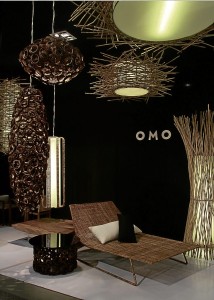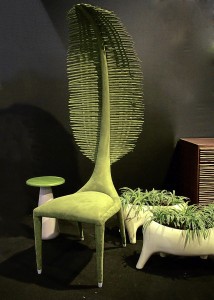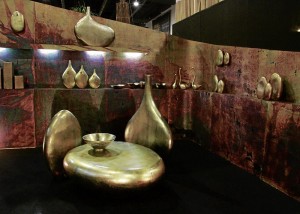

Lowly GI sheets are shaped into cutesy mobiles; nylon fishing nets, woven with abaca, are turned into tapestry; intricate patterns on handmade paper are imprints of raindrops; turned balusters are made into chairs; and palm fronds become back rests.
In the eyes of designers from the First World, Philippine products are superior not only because of the cultural tradition, but also for their ability to inspire or stir feelings.
When American retail veteran James Booth was made project head of last week’s Manila FAME, he developed the concept “The Art of the Craftsman Equals the Soul of the Philippines.” That reflected his faith in our country.
“I have been coming to the Philippines since 1978. Theirs is a truth that speaks through the product. That truth has deep roots in heritage and culture. It is a language all its own,” he said. “There is quality of execution of the design. This is where the care and delight come into the craftsman’s work.”
In the pursuit of industrialization, First World countries have invariably divorced themselves from their indigenous capabilities. Although their designs have harnessed technology to improve lives, the soul is missing.
In contrast, design in the Philippines has arrived, declared Booth. “It takes its lead from a wealth of design talent combined with a wealth of indigenous material. World exposure is refining more and more the authenticity of what the Philippines has to offer the design world.”
The crux of Manila FAME were the works of Philippine-based and Filipino designers with international experience. They either collaborated with local manufacturers or worked in their own companies to use local materials, inspired by native and natural themes, yet imbued with a contemporary flavor.

A striking trend is the interaction with other cultures, as shown in the works of Japanese designer Wataru Sakuma who was elevated into the Katha Hall of Fame, the design awards given by the Center for International Trade Expositions and Missions (Citem).
New York-based architect Calvin Tsao, a resource person in a forum, said, “Nations should find their own ground, welcome other thoughts, embrace them into their world. It’s cross-pollination.”
Booth described this phenomenon of Eastern and Western influence as the result of globalization.
“Because of technology and being connected 24/7, we are returning to our roots and heritage more and more today. I call it ‘hyperlocalism’ where local shapes global and global shapes local. These two phenomena are continuing to intersect and create new values, returning to old values and shaping a world that becomes a village.”
Raindrop patterns

Working for the Japanese paper pulp company Masa Ecological Development Inc. (Masaeco) in Tagaytay, Sakuma earned his reputation for intricate designs interpreted in handmade paper. Masaeco won the Best Booth in the Katha Awards for using recycled and sustainable materials in a simple but elegant way.
The booth was made with old pieces of wood found near the factory and pedestals from recycled plywood that were covered with pulp paper. The company exhibited its signature pieces, such as patterned piña and banana screens, which created an interplay of textures.
Sakuma’s other exhibit featured his signature salago paper, whose patterns were made from raindrops. The sheets were lined like books to symbolize the unfolding story of Filipino craftsmanship.
London-based industrial designer Daniel Latorre Cruz put up a workshop inspired by primitive western tools using local materials such as bamboo, buri and local lumber to make toys. “The shaving horse and pole lathe for wood turning were used by the Saxons. These tools were made from felled trees. It’s ideal for places where there is no electricity such as the mountains. They could be used here as they are self-sustaining,” he said.
On top of the exhibit was a large lamp, inspired by pagodas in a temple, made from rattan with a burnished finish.
The rug and pillow samples of New York-based designer Iñigo Elizalde attracted foreign buyers for their strong geometric shapes and bold colors, evoking the jeepney motifs and patterns from ethnic textiles and the abel Iloko.
Robert Alejandro elevated the lowly galvanized iron into playful mobiles using fine metal cutters. Commonly used for roofing, the GI sheets were transformed into the sun, moon, stars and kinetic birds that could be displayed in the garden.

Paris-educated French-Filipina textile designer Olivia D’Aboville gained her reputation for transforming common objects such as cocktail stirrers and synthetic materials into images of sea life. She worked with local weavers who combined her signature materials of fishnet with abaca to produce sheer fabrics with unusual textures. The nylon threads of ropes used for fishing boats were incorporated into indigenous fibers to produce a panel with uneven edges.
An abaca panel was woven with plastic straw that produced a three-dimension effect. For other manufacturers, she designed smoked capiz lamps that suggested fluidity or floating sea creatures.
Bell jar lamps
New York-based industrial designer Stanley Ruiz adopted the caravan as theme. He juxtaposed a wire-framed ox with scaffolding (that was used to set up a booth) to display terra-cotta vases, planters and resin stools with bold patterns and his rattan chairs designed for the American company Jonathan Adler.
He elevated the cheap Monobloc chair into a chic item by covering it with black-lip pearl mosaic finishing. Ruiz’s award-winning log speakers made from pulp by Masaeco were ordered by Anthropologie store.
Milo Naval’s lounge was furnished with pieces which he designed for other manufacturers using mahogany and engineered wood. It showed his signature as an interior designer—clean horizontal lines and natural finishes.
As rattan was a trend in the ’80s and ’90s, Naval presented new uses and finishes for his retail line OMO. He produced hanging lighting fixtures covered with rattan sticks and sleek furniture finishes of the same material. Shaved coconut husks, traditionally made for polishing floors, adorned side tables.
Ito Kish served as visual merchandising director and also focused on the Garden Pavilion. Although the Manila FAME’s theme was nationalistic, the pavilion presented a global world view with settings inspired by Britain, America, Asia and France. The pavilion presented the best of 28 manufacturers for outdoor decor.
Kish’s booth made a statement on conservation by using salvaged wood, old lattices and architectural fragments and illustrations of iconic ancestral homes in Quiapo. Last FAME show, his chair, made from turned balusters, won the Katha award. This time, the turned balusters were used in cabinets. His piece de resistance was the bell jar converted into a lamp.
‘Tropical moderne’
Budji + Royal Design Architects showcased its signature Tropical Moderne look, showcasing Budji Layug’s furniture and collaborations with suppliers such as Maricris Brias and Luisa Robinson. It was all about neutral and earthy colors, mixing textures, using traditional wood in modern proportions and mixing with modern materials.
The first setting showed a modern look—a streamlined bamboo sofa with narra burl side table and an occasional chair made of kamagong. High-backed chairs inspired by the ribs of a folding fan were done in steel.
In the second setting, Layug focused on his signature bamboo look, exaggerating the proportions by using big bamboo pieces six inches in width and made into sectional sofas. Also featured was his signature X-shaped bamboo table with glass top. The exaggerated proportions made the user feel the sturdiness of bamboo.
While most kamagong (Philippine ebony) furniture tend to warp over time, the four-poster bed with a ledge was covered with extra-thick wood to suggest solidity.
Pratt-trained Cebuano designer Kenneth Cobonpue and other designer-collaborators presented the indoor-outdoor theme in a fun way. A cast resin coffee table doubled as planter; stone and resin four-legged vases and animal-shaped wall-mounted sconces and D’Aboville’s sea anemone lamps made from cocktail stirrers made for a lively arrangement. People loved the palm frond chair and the braided chair inspired by Rapunzel.
On the whole, Tsao lauded Manila FAME for the Filipino’s connection with its cultural roots. “I go to Milan Furniture Fair and it’s about taste, elegance, industrial finishing and technological advancement.
“In Paris’ Maison et Objets it’s about ‘finesse-ing.’ In New York, it’s a lot of intellectual thinking but they can’t make anything. There is no infrastructure to allow them to make it because America has moved to services and industry. The arts are gone. Here you can make it, you can think about it. There is so much creative energy here,” he said.
“The 20th century was about industrialization. Although it facilitates greater efficiency, something is missing—the soul. One thing that is still there is our sense of wanting a connection with people, nature and our own sensations. Industrialized countries have let go of their cultural heritage. Once that is gone, it’s hard to revive. However, the Philippines is still deeply connected to its cultural roots and its creative impulses.”








































